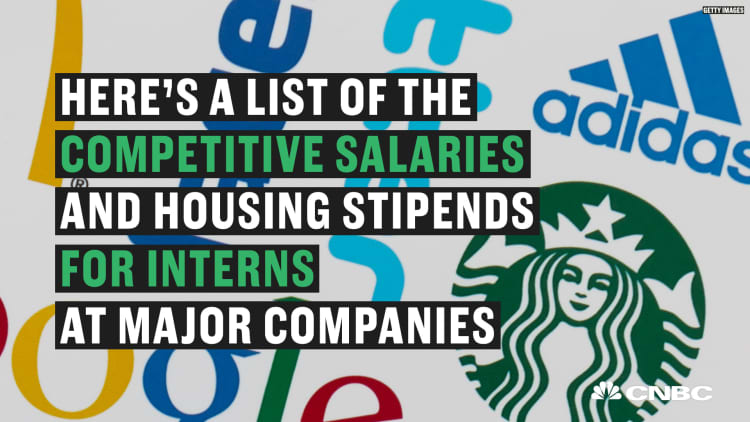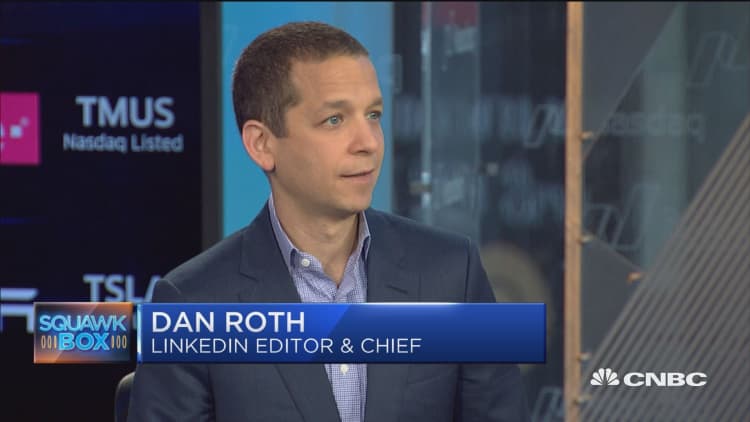There are companies. And then, there are companies where people really, really want to work.
Which are they? And what makes them so special?
Those two questions are what I've been thinking and talking about with thought leaders for the past few weeks, ever since LinkedIn shared with me its Top Companies of 2017, a massive, data-driven analysis that identifies the biggest talent magnets out there right now — the companies not where people necessarily like to work, although they might, but more so, where they yearn to.
And here's the bottom line. Most companies on the list are brand names. Many are audacious. And a lot of them are both.
More from Suzy Welch:
How to break bad news to your boss
5 ways to make a career comeback after kids
What should I do with my life? It comes down to 3 questions
Or put another way, the most attractive companies to job seekers today are entwined in our lives, and they're out to change the world, a one-two punch with implications for any employer who needs great talent to win. (Read: just about every single one.)
More on the composition of Top Companies list in a moment, but first, some quick background on the impressive research behind it.
Now in its second year, the list is derived from literally billions of user actions in LinkedIn's 500-million member database and other job-search databases, as well. All data was normalized for company size, so a giant healthcare company didn't have an advantage over a smaller player in the industry, and only companies with more than 500 employees were included in the data pool.
I could go into more depth about the study's methodology, and you can too, by clicking here, but suffice it to say, the research for LinkedIn's Top Companies list is unparalleled in its scope — and, to my mind, in the insight it provides into today's competitive job landscape.
Each list shows the strengths of its respective economy. Tech dominates the U.S. and India, while you'll find automakers on the German list, mining and construction companies in Australia, retailers and luxury giants in the U.K. and France, and popular local brands in Brazil.
In the U.S., the top five companies are, in order, Alphabet, Amazon, Facebook, Salesforce, and Uber, with Apple at No. 7. (For the record, and for the obvious reasons, LinkedIn removed itself from the list, along with Microsoft, which acquired LinkedIn last year.) Indeed, tech is strong through the entire 50-company list, with companies like Dell (No. 14), Workday (15), Twitter (17), Tableau Software (30) and DropBox (42) all appearing.
After tech, the industry with the most representation on the U.S. list is entertainment, holding three of the top ten spots, with Time Warner, Disney and Comcast coming in at Nos. 8, 9, and 10. Netflix shows up at No. 12. Auto makes an appearance at No. 6 with Tesla.
The rest of the list features a mixture of finance, consulting, and real estate, with McKinsey & Co. at No. 13, for instance, CBRE at No. 18, and Visa at No. 19. The lone retailer in the top 20 is sportswear's edgy new kid on the block, Under Armour, showing up at No. 16. And health care, which comprises nearly 30 percent of the U.S. GDP, doesn't show up until medical device maker Stryker, at No. 23.
As for market performance, most of the companies on the list are doing fine, thank you, with notable high-flyers No. 49 Square, whose stock has gone up 116 percent in the past year, Tesla, with shares up 57 percent, and Tableau Software, up 26 percent. But financial success doesn't seem to be an operative factor in the mind of job seekers.
If you had invested $10,000 a year ago in an equal-weighted portfolio of the 40 public companies on the U.S. Top Companies list, you'd be sitting on $11,589 now. The same amount invested in an S&P 500 index fund would be worth about $100 more, or $11,698.
Top Companies, in other words, are clearly not talent magnets because of their ROI. Or at least not in the traditional, how-does-this-help-my-401k sense. The investment here isn't dollars, it's years of your career. Which company is going to push you to your next level?
Many of the companies on the list, and especially those ranked highly, are brands we know, like, and often even love, embedded in our daily activities, impacting the way we play and work, and in many cases, setting the cultural conversation.
"This is all about brands. It's so emotional. People know these companies intimately," marketing guru Gary Vaynerchuk said of the list when I showed him an advance copy last week. "Working at most of these companies, it gives you bragging rights. Telling someone, 'Hey, I work at Amazon or Facebook or Apple,' is a lot better at the neighborhood barbecue than mentioning you work at some unknown or irrelevant company. It's got a coolness factor that gives you a badge of honor in any social setting."
And in professional settings, too. So says Silicon Valley leadership advisor, Liz Wiseman, author of Multipliers: How the Best Leaders Make Everyone Smarter. "People understand it makes much more sense to go where there's an exciting brand, because where there's an exciting brand, there's career growth," she says. "You'll learn and be given opportunity, instead of playing musical chairs when the budget isn't met."
Consider the apex of the list, Alphabet, the parent company of everyone's auxiliary brain, Google, which processes two trillion (yes, with a "t") searches a year, probably including several conducted by you before your first cup of coffee in the morning. And that's hardly the only way Google permeates our lives. The company now posts about $10 billion in advertising revenue per quarter.
Then there are Amazon and Facebook, brands without which no day would be complete for billions of us. Actually, make that no hour would be complete. With nearly 800 million iPhones currently in use worldwide, it's little wonder that Apple comes in at No. 7.
But Wiseman agrees brand alone doesn't fully explain which companies made the LinkedIn list. "It's fundamental to the value system of the Millennial generation to be a part of things that are of significance, that are bold, that are daring," she said.
That are, as I put it earlier, audacious.
Consider this: many Top Companies on the 2017 list are tackling stunningly hard problems with a never surrender mentality, inventing new technologies, and sometimes even creating whole new industries.
"The companies that show up really high on the list have set out to solve really big problems," observes LinkedIn's editor-in-chief, Dan Roth.
Roth notes there's been a significant change in management over the past decade. No longer are employees penalized for failing. They're penalized for not attempting the scary stuff. The companies on the Top Companies list, he observes, offer people that chance. "It's amazing," Roth says, "how much people demand to be challenged."

For more on the nature of work and culture at the Top Companies, I spoke with Al Ramadan, one of the authors of Play Bigger: How Pirates, Dreamers, and Innovators Create and Dominate Markets. Ramadan and his colleagues coined the term "Category Kings" to describe market-dominating companies that give us new ways of living, thinking, or doing business, often solving problems we didn't know we had.
"That's thrilling for a technologist, and really, for anyone," Ramadan posited. "Think about it. At many of these companies, you're coming up with new business models, and new pricing models, say. If you're a finance person, that's a hell of a challenge." Pointing to Airbnb, No. 11 on the list, he added, "That's a totally website-based company. Imagine if you're an experience designer. How to make the user experience great in unimaginable ways, that's a very cool problem you have to solve."
The companies are audacious, too, Ramadan said, in framing their missions in wildly aspirational ways. Forget business goals. They're gunning to rearrange the status quo.
"It's not about working for a company anymore for a lot of people. It's about joining a cause," Ramadan said. "Most of these companies are telling that story. We're not a business. We're a movement. Come join us."
That dynamic, he said, explains Uber's No. 5 ranking on the list, up one place from last year. You might have thought that the company's widely reported strife would have pushed it down a few notches. But Ramadan submits that Uber's troubles are secondary to job seekers, who remain drawn to its revolutionary zeal to reinvent the transportation system. (For much more on this, check out Caroline Fairchild's article, "If Uber has such a tough company culture, why does everyone want to work there?")
The same goes for Twitter, in the top 20 despite its much-discussed struggles to monetize and find an acquirer for itself. The company still beckons jobseekers, Ramadan says, because it has positioned itself as a catalyst to transform how we talk about news, politics, and, well, just about everything else.

Turning briefly from the companies that made the list in 2017, the experts I spoke with also had reflections on the companies that fell off the list from 2016. There were just six: Healthcare giant McKesson, Goldman Sachs, Estee Lauder, Viacom, Live Nation, and Fox.
"Goldman Sachs just burns people out too much. So does Amazon, but it's a great brand, people touch it every day," noted Dan Schwabel, business author and consultant. "And plus, it got too political in 2017. People are tired of politics."
Similarly, Schwabel theorized that Fox's bad press, largely around sexual harassment allegations, made it too hot to handle for most job seekers.
"People want to work at cool places right now," he said, "It's not about making money. It's about making an impression, and having an impact."
The companies who rise to the top of LinkedIn's Top Companies 2017 have figured out that being well known and being known to push for the stars is what attracts the stars. The combination is irresistible.
Plus:
The 25 hottest companies in America, according to LinkedIn
The 15 hottest companies in tech, according to LinkedIn
LinkedIn's full list of the Top Companies of 2017
The hottest companies in India, according to LinkedIn
This article originally appeared on Linkedin
Disclosure: Comcast is the owner of NBCUniversal, the parent company of CNBC and CNBC.com.



